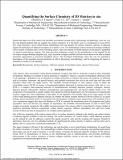Quantifying the surface chemistry of 3D matrices in situ
Author(s)
Tzeranis, Dimitrios S.; So, Peter T. C.; Yannas, Ioannis V.
DownloadYannas_Quantifying the.pdf (1.716Mb)
PUBLISHER_POLICY
Publisher Policy
Article is made available in accordance with the publisher's policy and may be subject to US copyright law. Please refer to the publisher's site for terms of use.
Terms of use
Metadata
Show full item recordAbstract
Despite the major role of the matrix (the insoluble environment around cells) in physiology and pathology, there are very few and limited methods that can quantify the surface chemistry of a 3D matrix such as a biomaterial or tissue ECM. This study describes a novel optical-based methodology that can quantify the surface chemistry (density of adhesion ligands for particular cell adhesion receptors) of a matrix in situ. The methodology utilizes fluorescent analogs (markers) of the receptor of interest and a series of binding assays, where the amount of bound markers on the matrix is quantified via spectral multi-photon imaging. The study provides preliminary results for the quantification of the ligands for the two major collagen-binding integrins (α[subscript 1]β[subscript 1], α[subscript 2]β[subscript 1]) in porous collagen scaffolds that have been shown to be able to induce maximum regeneration in transected peripheral nerves. The developed methodology opens the way for quantitative descriptions of the insoluble microenvironment of cells in physiology and pathology, and for integrating the matrix in quantitative models of cell signaling.
Date issued
2014-03Department
Massachusetts Institute of Technology. Department of Biological Engineering; Massachusetts Institute of Technology. Department of Mechanical EngineeringJournal
Proceedings of SPIE--the International Society for Optical Engineering
Publisher
SPIE
Citation
Tzeranis, Dimitrios S., Peter T. C. So, and Ioannis V. Yannas. “Quantifying the Surface Chemistry of 3D Matrices in Situ.” Edited by Samuel Achilefu and Ramesh Raghavachari. Reporters, Markers, Dyes, Nanoparticles, and Molecular Probes for Biomedical Applications VI (March 5, 2014). © 2014 Society of Photo-Optical Instrumentation Engineers (SPIE)
Version: Final published version
ISSN
0277-786X